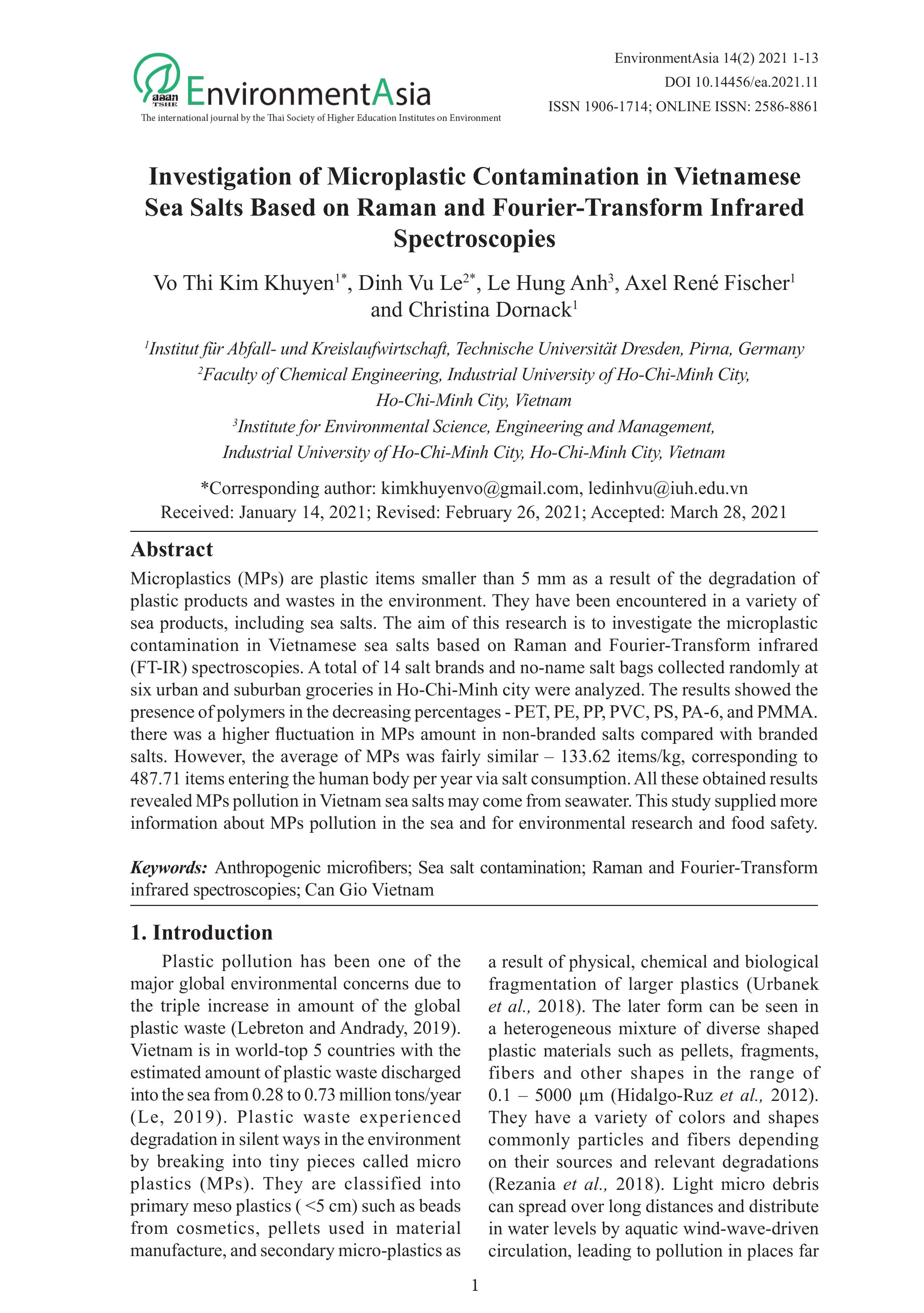Thư viện tri thức trực tuyến
Kho tài liệu với 50,000+ tài liệu học thuật
© 2023 Siêu thị PDF - Kho tài liệu học thuật hàng đầu Việt Nam

Tài liệu đang bị lỗi
File tài liệu này hiện đang bị hỏng, chúng tôi đang cố gắng khắc phục.
Investigation of Microplastic Contamination in Vietnamese Sea Salts Based on Raman and Fourier-Transform Infrared Spectroscopies
Nội dung xem thử
Mô tả chi tiết
1
Abstract
Microplastics (MPs) are plastic items smaller than 5 mm as a result of the degradation of
plastic products and wastes in the environment. They have been encountered in a variety of
sea products, including sea salts. The aim of this research is to investigate the microplastic
contamination in Vietnamese sea salts based on Raman and Fourier-Transform infrared
(FT-IR) spectroscopies. A total of 14 salt brands and no-name salt bags collected randomly at
six urban and suburban groceries in Ho-Chi-Minh city were analyzed. The results showed the
presence of polymers in the decreasing percentages - PET, PE, PP, PVC, PS, PA-6, and PMMA.
there was a higher fluctuation in MPs amount in non-branded salts compared with branded
salts. However, the average of MPs was fairly similar – 133.62 items/kg, corresponding to
487.71 items entering the human body per year via salt consumption. All these obtained results
revealed MPs pollution in Vietnam sea salts may come from seawater. This study supplied more
information about MPs pollution in the sea and for environmental research and food safety.
Keywords: Anthropogenic microfibers; Sea salt contamination; Raman and Fourier-Transform
infrared spectroscopies; Can Gio Vietnam
EnvironmentAsia 14(2) 2021 1-13
DOI 10.14456/ea.2021.11
ISSN 1906-1714; ONLINE ISSN: 2586-8861
Investigation of Microplastic Contamination in Vietnamese
Sea Salts Based on Raman and Fourier-Transform Infrared
Spectroscopies
Vo Thi Kim Khuyen1*, Dinh Vu Le2*, Le Hung Anh3
, Axel René Fischer1
and Christina Dornack1
1
Institut für Abfall- und Kreislaufwirtschaft, Technische Universität Dresden, Pirna, Germany
2
Faculty of Chemical Engineering, Industrial University of Ho-Chi-Minh City,
Ho-Chi-Minh City, Vietnam
3
Institute for Environmental Science, Engineering and Management,
Industrial University of Ho-Chi-Minh City, Ho-Chi-Minh City, Vietnam
*Corresponding author: [email protected], [email protected]
Received: January 14, 2021; Revised: February 26, 2021; Accepted: March 28, 2021
1. Introduction
Plastic pollution has been one of the
major global environmental concerns due to
the triple increase in amount of the global
plastic waste (Lebreton and Andrady, 2019).
Vietnam is in world-top 5 countries with the
estimated amount of plastic waste discharged
into the sea from 0.28 to 0.73 million tons/year
(Le, 2019). Plastic waste experienced
degradation in silent ways in the environment
by breaking into tiny pieces called micro
plastics (MPs). They are classified into
primary meso plastics ( <5 cm) such as beads
from cosmetics, pellets used in material
manufacture, and secondary micro-plastics as
a result of physical, chemical and biological
fragmentation of larger plastics (Urbanek
et al., 2018). The later form can be seen in
a heterogeneous mixture of diverse shaped
plastic materials such as pellets, fragments,
fibers and other shapes in the range of
0.1 – 5000 µm (Hidalgo-Ruz et al., 2012).
They have a variety of colors and shapes
commonly particles and fibers depending
on their sources and relevant degradations
(Rezania et al., 2018). Light micro debris
can spread over long distances and distribute
in water levels by aquatic wind-wave-driven
circulation, leading to pollution in places far